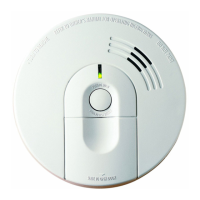2
AGENCY ALARM PLACEMENT RECOMMENDATIONS
Invensys Controls Americas recommends complete coverage protection achieved by
installing a smoke alarm in every room of your home.
The National Fire Protection Association’s (NFPA) minimum
requirement, as stated in Standard 72, Chapter 2, reads as follows:
“2-2.1.1.1 Smoke detectors shall be installed
outside of each separate sleeping area in the
immediate vicinity of the bedrooms and on
each additional story of the family living unit
including basements and excluding crawl
spaces and unfinished attics. In new construc-
tion a smoke detector also shall be
installed in each sleeping room.”
Chapter 2 also reads as follows:
“2-2.2.1 In new construction, where more than one smoke detector is required by 2-
2.1, they shall be so arranged that operation of any smoke detector shall cause the
alarm in all smoke detectors within the dwelling to sound.”
“2.5.2.1 The required number of smoke detectors might not provide reliable early
warning protection for those areas separated by a door from the areas protected by
the required smoke detectors. For this reason it is recommended that the household-
er consider the use of additional smoke detectors for those areas for increased pro-
tection. The additional areas include the basement, bedrooms, dining room, furnace
room, utility room and hallways not protected by the required smoke detectors. The
installation of smoke detectors in kitchens, attics (finished or unfinished), or garages
is not normally recommended, as these locations occasionally experience conditions
that can result in improper operation.”
This equipment should be installed in accordance with the National Fire Protection
Association’s Standard 72, NFPA, Batterymarch Park, Quincy, MA 02269.
THIS STANDARD MEANS YOU SHOULD INSTALL AND USE A SMOKE ALARM
IN EVERY ROOM AND AREA OF YOUR HOUSEHOLD OR BUILDING FOR BEST
PROTECTION.
Also, as required by the California State Fire Marshal:
“Early warning fire detection is best achieved by the installation of fire detection
equipment in all rooms and areas of the household as follows: a smoke detector
installed in each separate sleeping area (in the vicinity, but outside the bedrooms),
and heat or smoke detectors in the living rooms, dining rooms, bedrooms, kitchens,
hallways, attics, furnace rooms, closets, utility and storage rooms, basements and
attached garages.
Important Smoke Alarm Placement
and Exception Information
• Install a smoke alarm as close to the center of the
ceiling as possible. If this is not practical, mount no
closer than 4 inches from a wall or corner. Also, if
local codes allow, install smoke alarms on walls,
between 4 and 12 inches from ceiling/wall
intersections.
• Install a minimum of two smoke alarms in every
home, no matter how small the home. New
construction codes require a minimum of two
interconnected smoke alarms in newly built homes.
• Install a smoke alarm in each room that is divided by a partial wall (either coming
down from the ceiling at least 24 inches, or coming up from the floor).
• Install smoke alarms on peaked, cathedral, or gabled ceilings 3 feet from the
highest point (measured horizontally).
•
Install a smoke alarm in lived-in attics or attics which house electrical equipment
like furnaces, air conditioners, or heaters.
For best protection, install a smoke alarm in EVERY room. In addition, we recom-
mend that all smoke alarms be interconnected.
Different Types of Smoke Alarms
The ionization type alarms are generally more effective at detecting fast, flaming
fires which consume combustible materials rapidly and spread quickly. Sources of
these fires may include flammable liquids or paper burning in a waste container.
The photoelectric type alarms are generally more effective at detecting slow,
smoldering fires which smolder for hours before bursting into flame. Sources of
these fires may include cigarettes burning in couches or bedding. However, both
types of alarms are designed to provide adequate detection of both types of fires.
If you desire the benefits of both systems, you should install smoke alarms that
combine in one alarm both photoelectric and ionization sensing technologies.

